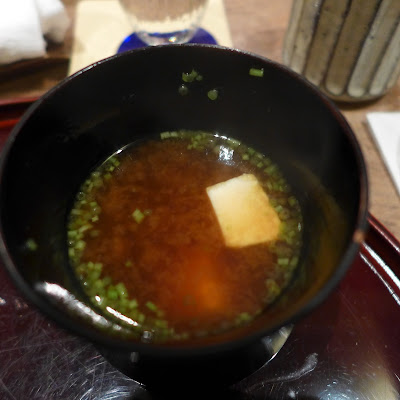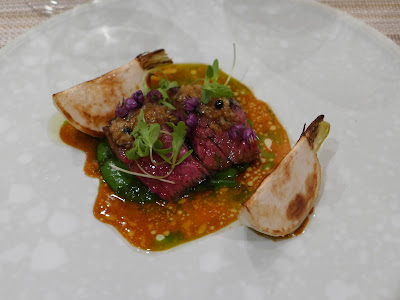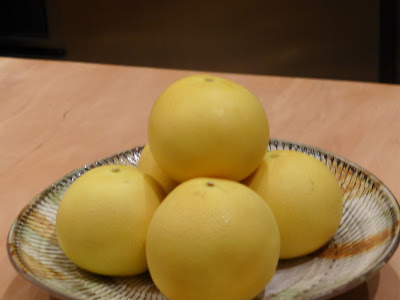Tokyo, Japan 2016, Part 2
Fall foliage.
OKAMOTO
Okamoto is a Michelin 2** kaiseki restaurant with 8 counter seats, an introduction only restaurant.
Mackerel sushi wrapped in nori.
The mackerel nside the nori wrap.
Shrimp tempura with yurine (lily bulb) and mitsuba leaves (no photo).
Soup with soft-shell turtle, ginger, arrowroot tofu, winter melon and leek.
Buckwheat
noodles topped with shaved bottarga.
Matsutake
mushrooms rolled with pike eel.
Hassun:
Burdock and fried soy
bean curd with sesame sauce and ginkgo nuts.
Abalone, daikon radish, kidney beans with white soy bean sauce.
Eggplant noodle with okra and sea weed.
The bowl containing the rice with chestnuts.
The presentation of the rice and chestnuts.
The whole presentation with the beef, matsutake mushrooms and rice with chestnuts.
Spring roll filled with red bean paste (adzuki beans) and grilled fig with yogurt sorbet.
Hokake
Hokake is a sushi restaurant.
The humble entrance.
First presentation.
Shirasu (Japanese baby sardines).
Striped jack.
Sardine.
Snapper.
Baby snapper.
Striped jack
Maguro tuna.
Chu-toro tuna.
Toro tuna.
Gizzard shad (Tokyo Bay).
Hamaguri (Asian clam) from Kuwana.
Shako (mantis shrimp).
Prawn.
Baby scallop.
Salmon roe (when exposed to the best in Japan salmon roe, the exceptional experience makes tasting salmon roe experience in the USA or Canada pale in comparison).
The busy counter and a box of pristine urchin (uni).
Sea urchin from Rishari, basted with house made soy sauce.
Squid.
Tuna roll.
Cucumber roll.
Gourd strip roll.
A gourd.
Tomago, Japanese omelette. This very tasty tomago was beautifully done with a caramelized surface.
Yama-no-chaya
Yama-no-chaya is a michelin 1* restaurant specializing in freshwater eel (unagi) and has been around for about 100 years. The Hie shrine that is adjacent to has been around for about 400 years.
Entrance.
Our private room.

The tokonma (alcove of honour).
Sesame custard.
Grilled eel liver.
Unseasoned grilled eel.
Grilled eel with sweetened soy sauce.
Soup presentation.
Red Bean soup.
Rice
Pickled veg (no photo).
Persimmon (the seasonal fruit).
Sato Burian
Sato Burian, a yakiniku restaurant, is a play on the word chateaubriand and serves up high grade cuts of superior Japanese beef, mostly from Kyushu (Kumamoto and Kagoshima).
Today's beef selection.
Beef stew.
Spicy pickled Chinese cabbage and radish
Beef tongue and skirt steak.
Ground beef with tofu salad.
Cooking the beef over bincho charcoal.
The tongue.
Top round, cap off.
Searing.
Searing the tongue.
Chateaubriand sandwiches.
Seared filet.
Filet ready to be cooked sukiyaki style.
The broth made with sukiyaki sauce and flying fish broth.
The beef cooking in the broth.

A really fresh raw egg. Beautiful yolk.
The cooked beef on the plate.
Add the really fresh raw egg and ta -da! the delicious beef sukiyaki.
Daikon for contrast.
Chteaubriand and pristine sea urchin.
Searing the chateaubriand over bincho charcoal with butter sauce.
Chateaubriand topped with sea urchin.....was that a terrific, delicious indulgence.
And now, the chateaubriand topped with over the top sea urchin and sevruga caviar!
Cold noodles Korean style.
We were served grape sorbet for dessert (no photo).
Sushi Sawada
Sushi sawada is perhaps my favourite place to eat sushi in Japan. Unfortunately, photos are not allowed. However, listed below are the items in this season's meal:
Sushi:
Flounder
Ink Squid
Sand borer (prepared between sheets of kelp).
Arch shell (akagai).
Striped jack that had been aged (from the premium location of Mikura Island)
Abalone that had been steamed for 5 hours in salt and sake
Salmon roe that was delectably fresh (although everything was).
Common orient clam (hamaguri) (early season).
Gizzard shad.
Bonito from Wakasa Bay (premier location) that had been smoked with straw (so good, I had seconds!).
Mackerel marinated in vinegar.
Stuffed baby squid with shiso rice (inro-maki).
Tuna (maguro) marinated in house made soy sauce.
Chutoro (medium fatty tuna).
Shimofuri (grade between medium and most fatty tuna).
Otoro (most fatty tuna).
Otoro, broiled on one side with bincho charcoal.
Pickled daikon radish.
Pacific fat gaper saltwater clam.
Sea urchin from premium Kombumori in Hokkaido.
Sea eel with salt and wasabi and house made thick soy sauce.
Tomago (omelette).
Tuna roll.
Veggie roll.
Goryu Kubo
Goryu Kubo is an esteemed Michelin 2** kaiseki restaurant.
Persimmon, shiitake mushroom with sesame sauce.
Our lovely sake jar.
Presentation.
Glutinous rice steamed after marinated in sake, with chestnuts and ginko.
Our sake being cooled in a beautiful wood cooler.
Grilled kinki (channel fish) and small turnip from Kyoto with soup.
Presentation.
Steamed abalone and Yamashina eggplant from Kyoto, with creamy broth.
Seiko crab, female of snow crab made with crab broth mixed with vinegar. Under the crab meat is the most wonderful roe.
Shirakawa (white tile fish), fried, topped with sahved daikon, with broth.
Charbroiled wild eel premier sourced from Shinji Lake, with sansyo nuts and leaves.
Rice with black throat sea perch.
Rice with Black Sea sea perch, plated.
Pickles.
Cold buckwheat boodles with nameko mushrooms.
Kyoho grape and white wine jelly accompanied by green tea. By the way, note the sake glass to the right. I really liked it and received the info about the factory where it is made and sold. However, when I priced the glass at the factory, it was $650.00!! This is a risk that no North American resto would take, being concerned about breakage, whereas the very best restos in Japan are perfectionist in the details.
Asabuyukimura
Yukimura is one of the very few Michelin 3*** restos in Tokyo. The chef was in Kyoto for many years and relocated to Tokyo. His take is an urban kappo perspective on Kyoto style kaiseki cuisine. Tonight the chef was out of town and his senior served us.
Grilled lilly bulb with sesame paste and dried sea cucumber ovary.
Chawan mushi (egg custard) with the internal organs of the sea cucumber.
The presentation: snow crab and roe, fried lotus, fried chestnuts and boiled black beans from Tamba, Japanese cheese and manganji pepper.
The female snow crab and roe.
Live Taiza crab, a rare delicacy.
Crab close up, note the green tag with orgin and boat details.
Soup with pike eel dumpling and white soy sauce.
The living crab was literally pulled apart by hand, in front of us, the legs sectioned and some shell removed. The crab roe was served as well.
The claw was steamed.
Crab meat, tomalley, rice and crab roe served together in the shell, topped with scallion.
Crab tomalley and meat.
buckwheat noodle with spicy radish in soup, sided with salmon roe.
The salmon roe was exceptionally fresh.
Close up of the soup.
Grilled duck with sancho sauce and served with Ebiimo potato.
Pickled chrysanthemum leaves.
Chestnut rice.
The chestnut rice served with the pickled chrysanthemum leaves.
Miso soup.
Seasonal persimmon.
Sugar candies.
Sugalabo
Sugalabo ranks among the very best restos in Tokyo. It is virtually impossible to get a reservation unless one is known to the chef, Yosuke Suga, a chef who formerly held major positions working for Joel Robuchon, one of the very great chefs of the world. There is no published telephone number and there is no sign in front of the resto. In fact the sign is misleading and only an inside manager controls the secret passage entryway to escort one inside.
This is the restaurant sign. Looks like its a coffee ship from the street, but when you get close, note the small print in the bottom right corner.
My good friend Toshio was very good friends with the chef, which was how we got a res. Here, Toshio escorts us in to the false entrance, now open.
The receptionist further opens the false wall to reveal a door.
Entering the resto.
A macaroon made in Kyoto style with a thin cracker like crust hides botarga inside.
Daikon mochi.
Cod sperm "kitch" with pine nuts, chorizo Iberico and capers.
An extraordinary prociutto style ham made in Japan! The flavour was remakable complex, the fat creamy, a dream to taste. The ham was draped over a Japanese seki cheese, aged 24 months.
Botan ebi (sweet shrimp sashimi) and sea urchin. The sea urchin had just been flown in from the best urchin location, Hokkaido, at 2pm this afternoon.
Surimi of scallop with scallop juice foam, perilla flowers, leeks from Kyoto (kujo) and white Alba truffle.
Snow crab and barley with kabosu lime.
Charred kinki (red snapper) with lilly bulb, ginko nuts, gohji berries, espellette pepper and white mushroom.
Tottori beef from the southwest region of Japan, near Hiroshima, with chrysanthemum greens, turnip and mushroom sauce.
Japanese curry with rice and pickled rakyo (like a shallot)
Pomelo "Buntan", a sweet fruit with a mild grapefruit like taste made into a jelly with espume of lemon over chocolate mousse (covered with whipped egg white).
What the pomelo Buntan looks like.
Tiramisu with 25 year aged balsamic vinegar
Madeleines fresh from the oven.
Mascarpone ice cream with coffee mousse and persimmon from Fuju).







































































































































No comments:
Post a Comment